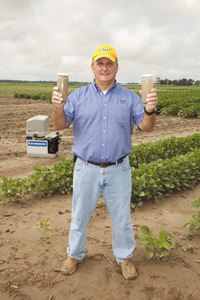|
Mindful Of Environment
Farmers Can Tweak Practices To Produce, Save Environment
BETTY VALLE GEGG-NAEGER
MidAmerica Farmer Grower
ST. JOSEPH, LA
Demonstrations at the Crop Production Field Day at St. Joseph, La., showed farmers there are ways to increase production while also preserving the environment. James Hendrix of the Master Farmer Program at the LSU Ag Center presented the program.

James Hendrix of the Master Farmer Program at the LSU Ag Center, explains ways farmers can preserve the environment while increasing production.
Photo by John LaRose, Jr.
“This is a site that is actually an off-site demonstration for a 319 project that we’re implementing on an impaired watershed in this parish,” he explained. “We are demonstrating several different soil management practices on commerce silt loam soil, including tillage systems and cover crops, as well as various turn-row practices to show how effective each is in controlling erosion.”
Six different treatments, including field combinations of winter covers of wheat and natural vegetation, turn-rows with bare ground, wheat or natural vegetative covers and tillage practices, including conventional till, stale seedbed and no till were shown. Each of the different scenarios can vary greatly in effectiveness of trapping sediments that are running off the field during rainfall events.
“I have some samples here that we have taken,” Hendrix continued. “This is a sample from one of the off-site demonstrations that was from a conventional till system, including a turn-row that had no vegetative cover, and the other one was from a no-till system with a wheat crop and turn-row planted in wheat.
“On the demonstration plots here at the Northeast Research Station, we burned down the wheat cover crop in late February with glyphosate and 2,4-D and followed up in March with glyphosate alone. On some other off-station demonstration sites we actually maintained the wheat turn-row to maturity instead of destroying it by chemical burn-down; what we like to do is go in and just bush hog it so we’ll still have the good root structure and residue to trap sediments.”
Normally, after low biomass crops such as soybeans or cotton have been harvested, October through April are months that soils, if unprotected, could be highly vulnerable to erosion. Planting a cover crop can greatly reduce this erosion potential, but may not be the producer’s choice or decision. Planting a winter cover on the turn-row, such as wheat, can be of benefit in reducing soil erosion and nutrient loss.
“We have seen adequate wheat roots and residue still in place as late as July that complements the warm season natural vegetation in protecting the soil and filtering runoff from the field,” he said.
Hendrix had a few closing words for farmers:
“I think the important thing we’ve learned is that we need producers to become more and more conservation minded. They should look at what best management practices will fit their system best, implementing research based information provided by research stations and their extension service to come up with the best scenario. The soil is very important, that’s how we produce our crops. We know we have to increase production, but we also realize we must protect the environment. So decide on the best conservation-minded production scenario for your farm, and I think you’ll have a sustainable system.”∆
BETTY VALLE GEGG-NAEGER: Senior Staff Writer, MidAmerica Farmer Grower
|
|